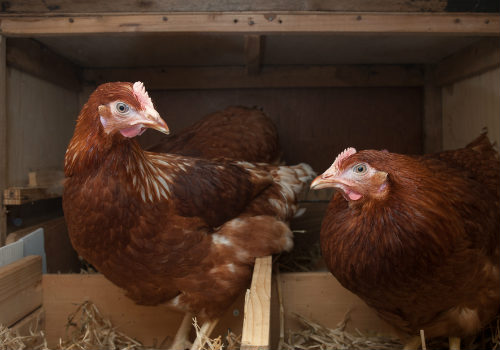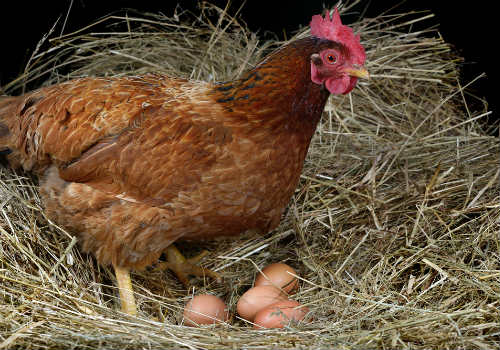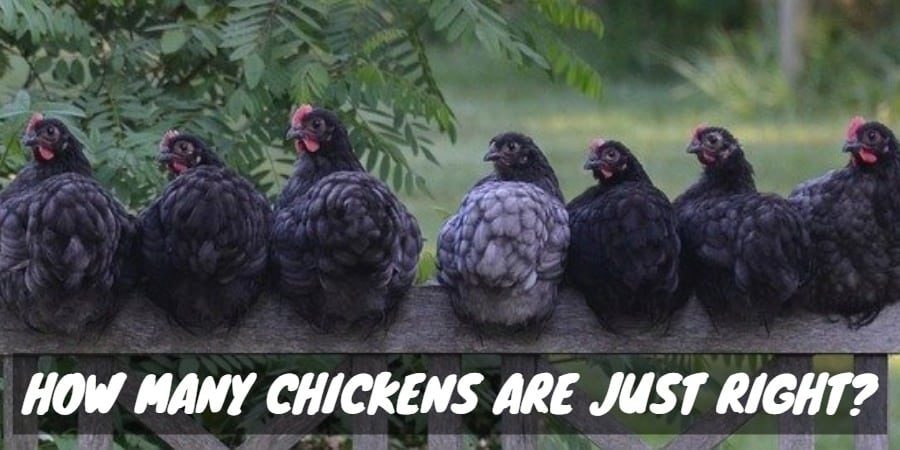Experts recommend that you have one nesting box per five chickens. Best practices for animal welfare and husbandry recommend no more than three to four hens per nesting box. The Department of Environment, Food and Rural Affairs recommends no more than seven chickens share a nesting box.
As you can see, there is a fair amount of variation within nesting box guidelines. The reason for this is that different hens will have different needs. If you have heavy layers, you may need more nesting boxes to accommodate the number of eggs you are collecting. Smaller chickens and those that don’t lay as frequently can get by with fewer nesting boxes as they will not be as prone to overcrowding.
If some of your hens tend to lay in the morning and others in the afternoon or evening, you may need fewer boxes than if all of them were morning layers. Individual chicken personalities, breed differences and environmental factors can all affect the ideal number of chickens per nesting box.

Most hens are happy to share a nesting box. Chickens are social animals, and two or more hens will sometimes choose to share a single box even if there is another free box available. However, having too many hens and too few nesting boxes can lead to trouble. Chickens who don’t have options may become stressed, which can affect egg production. Overcrowded boxes can also lead to broken eggs, and stressed hens may sometimes break or even eat eggs. Hens forced to share an overcrowded nesting box may also start fighting.
For all of these reasons, it’s better to err on the side of caution when deciding how many chickens can share a nesting box. If you have the space, it’s always better to give your hens plenty of room and options. For reasons of economy, you might want to start with the minimum number of nesting boxes required for your hens, then add nesting boxes as necessary to make them happy. For example, if you have ten chickens, you might want to start with two boxes and add a third or even fourth if you have an issue with egg production, broken eggs or stressed-out hens.
How to Set Up Nesting Boxes for Your Hens
Chickens will instinctively seek out a quiet and secluded place to lay eggs. If they don’t have a nesting box, chickens may seek out a secluded area on their own. This means that you might have to go on an egg hunt every day when trying to collect your eggs. It’s always better to provide a nesting box that will entice the hens to lay their eggs in an easy-to-access location.
Nesting boxes don’t need to be fancy. They can be handmade or purchased pre-assembled. When buying or building a nesting box, there are a few qualities to look out for:
– It should be easy to clean. Because the box will be holding your eggs, you’ll want it to stay reasonably sanitary. A clean box will also be more enticing for the hen, who may decide to lay elsewhere if the box is not clean and comfortable.

– Consider using a non-porous material. Although good nesting boxes can be made from wood, porous materials are harder to keep clean and can harbor bacteria and parasites. Choosing metal or plastic helps prevent moisture retention and aids in cleaning.
– It should have a slanted roof or top. The box needs to be fully enclosed to provide the hen with a feeling of safety and security. A flat roof may encourage roosting or perching on top of the box, which could be messy. Instead, opt for a sloping or pitched roof that will discourage roosting so the nesting box can be kept clean.
– It should be large enough for your hens. The size of your chickens will affect the size of the nesting box you choose. Most hens do well with a 12-14″ square box. Larger breeds may require a larger box. Smaller hens, like bantams, can get by with a smaller box. You need the space to be small enough to feel cozy and secure to the hen but large enough to accommodate two hens who decide to lay at the same time.
You’ll have an easier time keeping the nesting box clean if it’s mounted above ground level. If your hens are poor flyers, you might want to build a ramp that will help them reach the box. However, the nesting box should be kept at a lower level than the perch, so the hens are not tempted to sleep in the box. That will keep the eggs protected and eliminate some of the messiness that can come from roosting hens.
Once you’ve chosen your boxes and mounted them at the appropriate height, you’ll want to include some bedding. The bedding should be deep enough that it will protect the newly laid eggs and prevent breakage from jostling. Wood chips or straw are common nesting materials that work well for this purpose.

What’s Wrong With having Too Many Nesting Boxes?
Since overcrowding your hens can cause issues with egg-breaking and territorial disputes, you may think that erring on the side of more nesting boxes would always be better. However, this can backfire on you. You don’t want too many nesting boxes as the chickens will not use all of them for their intended purpose. Since hens like to share a nesting box, the unused boxes might be used for roosting instead.
Chickens are messy animals who poop where they sleep. If your hens start to sleep in the nesting box, they’ll make a mess inside as well. This can lead to the spread of germs and disease, and it gives you more to clean up. Hens with too many nesting boxes to choose from may also get into the habit of scattering their eggs between them, making egg collecting more arduous. You don’t want to be stuck collecting from 30 nesting boxes if you could collect from five or six instead!
Having too many nesting boxes is expensive, time-consuming and affects the cleanliness of the coop. Your chickens will not be bothered at all by sharing a nesting box, so don’t feel like you should have a separate box for each hen.





What about when you have one hen sitting on her eggs (we do have a rooster-but not for much longer!) and another chicken gets in the same box and lays eggs. How will I know which eggs belong to the one sitting and the one that decided to lay in the same nest? Is this a common thing with chickens?
I started keeping chickens a few months ago. I started with six, then added six more. I hope to get another half-dozen in a few weeks.
Before getting the hens, I had to make a place for them. An unused 6×10 dog pen seemed ideal. I put an old camping table that had become weather brittle along the far end and two old large dog houses on top of the table. I keep their feed in two round containers with screw lids in between and an extra bag of bedding material under the table. After adding their feed, the feeder goes under the table so the birds don’t poop in it at night while roosting.
I also bought some plastic egg crates (5), hung them up above the ground along one side, and stretched a PVC pipe longways in the pen for roosting. I covered the top of the pen with a tarp for shade and protection from flying nighttime predators.
Yesterday I had to completely redo the tarp, as there was no interior support, and rain made it sag uncontrollably. I had several lengths of PVC pipe from a leftover job. I cut six lengths, drilled zip tie holes in each end, and then connected those from the short side to the short side of the pen. Then I took
Five lengths and did the same long ways. Where the poles intersected each other, I zip-tied them together. Then I repositioned the tarp over the top and zip tied at the grommets.
A tree grew into a side of the pen, and I wanted to leave it to help with shade. Unfortunately, I had to cut the tarp to go around the tree, and it may leak there when it rains, but maybe that will keep rain sagging from happening in other areas. If not, back to the drawing board!
I placed another PVC pole across the pen for roosting but didn’t secure it so I could move it around as necessary.
My only purchases besides bedding material and feed were for some zip ties, the tarp, the egg crates, a feeder, and a waterer. Oh, and the chickens!! Everything else was repurposed.
The feeder doesn’t seem big enough for 12 hens to fit around, as there’s always one that runs around the perimeter looking for a space to get in. So I would sometimes put a little feed on the ground for her. I recently started using a large terra cotta tray from an old planter which broke to give them feed mixed with whey or old goat milk. They love the change! Now I put some feed in it, too, so they don’t have to fight for a place at the “table.”
The chickens seem to love it in there. They’re free to roam during the day but come and go to lay their eggs or whatever else they do.
They only use one dog house for laying their eggs, though I have occasionally found an egg in the other one – possibly because the first was occupied! It’s like they wait their turn in line! It makes collecting the eggs relatively easy!! Of 12 chickens, I consistently get 10-11 eggs daily, 12 occasionally, and even 13 one day. Even an extra large double-yolked egg once!!
I love my chickens!!!
I love chickens too! They’re so cool. 😉
Love this site. So cool. And so original name.